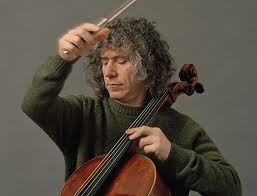Body Language For String Players
ECONOMY OF GESTURE ….. OR DANCE ?
We tend to think of music as being just sound, but when we go to a concert (or watch a video recording) a large part of our enjoyment comes not only from what we hear but also from what we see. For a live audience, musical performance – especially string playing – also has a large “dance” component, a large part of which comes from our right arm. We have all had the experience of watching a musician (or group) play all the notes perfectly but with such economy of movement that the overall effect is quite boring and mechanical even though an audio recording of the same performance might sound wonderfully expressive and musical. Jascha Heifetz and Janos Starker are two examples that come to mind. How much to “dance” and how much to be economical and sober with our body movements is a permanent subject of discussion amongst professional musicians, with those who move lots often being accused of cheap showmanship and attention-grabbing by their more formal colleagues.
Very often, our choice of bowings can add or remove dance elements from our playing. As-it-comes bowings (in which we simply alternate up and down bows as though we were using a saw to cut wood) are usually the most simple and economical bowings in terms of energy expenditure and intellectual effort but are also the most neutral/inexpressive in terms of body language. Even though the use of retakes may not be necessary from a technical point of view (bow division, bow bounce etc), their use can add a huge amount of interest, character, energy and attractiveness to the same notes because now our bow and right arm are obliged to move a lot more. This concept is valid for music of any speed and dynamic:

For a good illustration of the communicative power of body language, think about simple finger snaps. Often used in jazz pieces to set the pulse, or as a sort of informal percussion instrument (almost always used off the beat, on the syncopations), finger snaps are just not the same if performed drily, without the accompanying “dancing” gesture of the arm and even the upper body. But not only do they “look” better when “played” with the dancing gesture, they are also much easier to play in time if we move our body with the music. In fact, it is almost impossible to be out of time if our bodies are moving (dancing) with the rhythm.
We can move our upper body, swaying sideways, rocking forwards and backwards, and combining these movements. The rocking forwards and backwards is more limited and problematic than the side-to-side movements because displacement of the cello’s point of contact with our chest/sternum is quite destabilising. We can also move our head in many different directions, but it is our right arm that has by far the greatest possibilities of expressive movement at the cello. It is as though our right arm was our principal dancer, with the other parts of our body having far inferior roles (certainly as dancers). Most of this dancing takes place in the air, before and after the bow’s contact with the string (see Bow Trajectory In The Air).  We have great freedom to choose the amplitude of our gestures when we both take the bow away from, and bring it to, the string. Normally, our choice of the size of these movements will be determined by both the musical context and the nature of our personality. Shyness, introversion and intellectualism will tend to keep our dancer very close to the string, while exuberance, extraversion and emotivity will encourage our arm to use a much greater expressive range. These movements of the right arm in the air become an even more important element of our expressive toolbox in pizzicato, because the hand is in contact with the string for such a tiny fraction of the playing time, thus giving the approach to the string and the follow-through after the pluck, even greater expressive, choreographic potential.
We have great freedom to choose the amplitude of our gestures when we both take the bow away from, and bring it to, the string. Normally, our choice of the size of these movements will be determined by both the musical context and the nature of our personality. Shyness, introversion and intellectualism will tend to keep our dancer very close to the string, while exuberance, extraversion and emotivity will encourage our arm to use a much greater expressive range. These movements of the right arm in the air become an even more important element of our expressive toolbox in pizzicato, because the hand is in contact with the string for such a tiny fraction of the playing time, thus giving the approach to the string and the follow-through after the pluck, even greater expressive, choreographic potential.
We can also do some dancing during the bow’s trajectory on the string, most notably with the elbow (see Bow Trajectory On The String).
ERGONOMY AND PSYCHOLOGY
To have beautiful, ergonomic, fluid movements, we need to have a relaxed nervous system. Psychological tensions, fear, anxiety, nervousness, disorganised thought processes, distraction, and other states of psychological distress will all manifest almost invariably in our body language, creating problems of spatial and kinesthetic awareness, coordination, timing, and muscle control that can wreak havoc with our playing. See the Psychology section for more discussion about these subjects.
